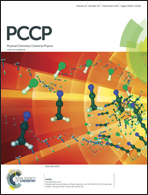Evidence for the intrinsic nature of band-gap states electrochemically observed on atomically flat TiO2(110) surfaces†
Abstract
Using an ultra-high vacuum (UHV) electrochemistry approach with pulsed laser deposition (PLD), we investigated the band-gap state for TiO2(110). In the PLD chamber, a TiO2(110) surface was cleaned by annealing in O2 enough for it to exhibit a sharp (1 × 1) reflection high energy electron diffraction (RHEED) pattern. The cleaned TiO2(110)-(1 × 1) sample then underwent electrochemical measurements without exposure to air, showing the band-gap state at −0.14 V vs. Ag by Mott–Schottky plot analysis. The band-gap state gradually disappeared under UV illumination at +0.6 V vs. Ag due to photoetching, and reappeared on reduction in a vacuum and/or deposition of a fresh TiO2 film. These results indicated that the electrochemically observed band-gap state for TiO2(110) was a defect state due to oxygen deficiency, most probably identical to that observed under UHV, which does not necessarily exist on the surface. A quantitative analysis of the defect density suggests that the origin of this defect state is not the surface bridging hydroxyls or oxygen vacancies, but rather the interstitial Ti3+ ions in the subsurface region.


 Please wait while we load your content...
Please wait while we load your content...